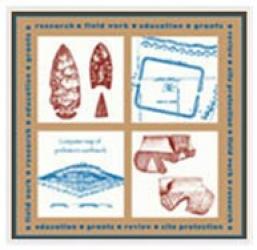
*Muscatatuck Urban Training Center - On April 12, State Archaeologist Amy Johnson conducted her first site visit to the Muscatatuck Urban Training Center in Jennings County to learn about the progress of the Phase III archaeological investigations which are being conducted by Cardno at site 12Jn447, a multicomponent precontact site. This work is being conducted under an archaeology plan approved by the DHPA. Johnson met with Cardno archaeologists, staff of the Indiana Army National Guard, and an archaeologist who works with the Miami Tribe of Oklahoma and was shown several of the archaeological features which have been discovered thus far. Check out this promo video of the next video in the “Forgotten Muscatatuck” series about the archaeological excavations that took place over six weeks.
*Phase II fieldwork- Archaeologists A.J. Ariens of the Division of Forestry and Rachel Sharkey of DHPA have been conducting a Phase II investigation at Ravinia State Forest near Martinsville, which was once the location of the Gossard Breeding Estate. The estate was owned by H. W. Gossard, a Chicago businessman and founder of the H.W. Gossard Company, a prominent corset manufacturing company in the early twentieth century. He later became interested in breeding and raising award-winning Berkshire hogs, Ayrshire dairy cows, and Percheron horses. Over the course of the breeding estate’s years in operation, numerous farm buildings, primarily barns, were built. In addition to the farm buildings, the mansion and the houses of many of the farm’s staff were located in the area. Many of the buildings were torn down once the estate was no longer in operation and the mansion burned in 1979. Today, much of what remains in the area are the foundations of the barns, while the remains of the house may have been bulldozed at some point.
The purpose of the investigation is to determine the extent and content of archaeological deposits, evaluate any disturbances to the site that happened after its occupation period, and to determine its potential eligibility for inclusion on both the National Register of Historic Places and the Indiana Register of Historic Sites and Structures. So far, archaeologists have found brick fragments, glass and melted glass, a hexagon-shaped tile, and other small clues from the habitation of the site by the Gossard family.

Rachel Sharkey takes notes during archaeological excavation work at the site (12Mg633).
Repatriation - Indiana University and several federally recognized tribal nations have completed the repatriation of the Angel Mounds collection in compliance with the Native American Graves Protection and Repatriation Act. This repatriation includes the remains of more than 700 individuals unearthed from the Angel Mounds National Historic Landmark and State Historic Site in Evansville starting in the 1930s.
Archaeology Site of the Month - In honor of the 25th anniversary of a statewide celebration of archaeology, we have been highlighting the 25th recorded archaeological site for each county in Indiana. This focus will span all 92 counties. Archaeological sites are each given a unique, sequential identification number as they are recorded. This helps archaeologists keep track of the artifacts that come from the site, and differentiates it from other sites in the area. The numbering system tells archaeologists what state and county a site comes from, and what the specific number in that county belongs to the site. For example, Angel Mounds is archaeological site 12-Vg-1, meaning it is from Vanderburgh County (Vg), Indiana (12), and is the first documented site in that county (1). In this newsletter, we are continuing our alphabetical march through the counties and highlighting the 25th site from Pulaski through Shelby counties.
Pulaski County 12-Pl-25: This site is a small lithic scatter of only two flakes and was documented by Ball State University in 1984 as part of a wastewater treatment plant expansion project.
Putnam County 12-Pm-25: This site was documented by F.M. Vreeland (DePauw University) in 1941. Unfortunately, Mr. Vreeland’s notes were not specific enough for the site to be relocated by other archaeologists in subsequent investigations.
Randolph County 12-R-25: Archaeologists and artifact collectors have visited this site repeatedly over the years. In some visits, hundreds of artifacts were identified, including pestles, celts, grooved axes, and side notched points.
Ripley County 12-Ri-25: This collector-reported site includes a multitude of Archaic projectile points, ranging from the Early Archaic through the Late Archaic.
Rush County 12-Ru-25: Artifacts noted at this site, recorded in 1982, consist of a scraper, waste flakes, projectile points and knives. Little other information is known about this site at this time.
Scott County 12-S-25: This is another collector-reported site that was recorded in 1978. The artifacts noted at the site include projectile points and lithic flakes.
Shelby County 12-Sh-25: This small camp site was recorded in 1949 by D.W. Dragoo. Artifacts recovered include pestles, projectile points, axes, and clusters of burned rocks. The site is located near a river and may now be buried under silt.
Archaeology Project- Check out this video about an exciting project being conducted by the Ball State Applied Anthropology Laboratories (“AAL”) to digitize more than 50 years of AAL archaeological research, making significant archaeological data readily accessible for the first time.
This information is distributed via email by the Indiana Department of Natural Resources, Division of Historic Preservation and Archaeology (DHPA). This is meant to provide information on current archaeological topics and issues in which the DHPA is involved. An archive of past Archaeology News issues is available. If you have any questions, do not hesitate to contact our office at 317-232-1646.

Mission Statement: The Division of Historic Preservation and Archaeology promotes the conservation of Indiana’s cultural resources through public education efforts, financial incentives including several grant and tax credit programs, and the administration of state and federally mandated legislation.
Division of Historic Preservation and Archaeology, 402 W. Washington St., Room W274, Indianapolis, IN 46204. www.IN.gov/dnr/historic, www.facebook.com/INdhpa
Indiana Archaeology Month (September) webpage - http://www.in.gov/dnr/historic/3674.htm
#INArchaeoMonth
